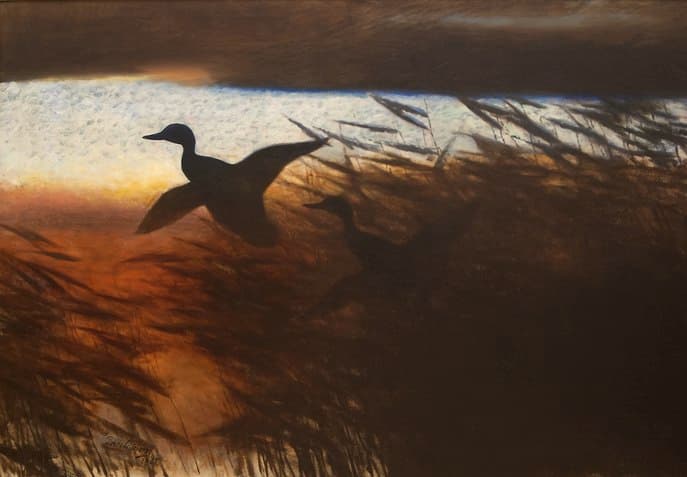Poem of the Day: ‘The Wild Duck’
What sounds to us, on a spring morning, like ambient noise is to the birds a multitude of separate languages, each one distinctly intelligible to its speakers, if to no one else.

Birds cast a peculiarly compelling spell on the human imagination. As ubiquitous as they are — sparrows pecking crumbs under outdoor tables around the world, pigeons squatting universally on statues, starlings swirling in great liquid masses on the evening sky as they filter down into the trees — they remain a mystery to us.
What sounds to us, on a spring morning, like ambient noise is to them a multitude of separate languages, each one distinctly intelligible to its speakers, if to no one else. They carry on their societies in the branches outside our windows. They see migratory highways where we see only sky. They are an entire order of creation whose world overlaps ours but rarely touches it. Whatever human beings have achieved in the way of flight, we still don’t know what it is to be a bird.
So it’s hardly surprising that birds should be a source of fascination for writers. The Englishman J.A. Baker (1926–1987) kept a diary, his 1967 “The Peregrine,” setting down his daily quest not only to observe the hawks hunting over the Essex saltmarshes but to find in himself the primal desire for survival that animates them. We have children’s novels of human-bird coexistence, notably Farley Mowat’s 1961 “Owls in the Family” and Jean Craighead George’s 1959 “My Side of the Mountain.”
All these ask What if?, on one level or another. What if the worlds of birds and humans not only overlapped but touched? If we can’t know what it is to be a bird, still we can, through some kind of established relationship, know what birds are like. Chiefly we can know the ways in which we are like them, and they are like us. Or so we speculate. And such speculations, such quests for understanding, are what drive narrative.
Poets, by and large, seem not to think this way, but to be satisfied with the mysterious chasm that yawns between the bird’s realm of experience and our own. The bird of Keats’ “What the Thrush Said,” for example, which ran as Poem of the Day in March of last year, embodies in itself the principle of negative capability: mystery as a form of extra-rational knowledge. If the thrush is like us at all, it’s only like us in knowing things that human language can’t articulate — things we know, but can’t say.
Likewise, Thomas Hardy’s “Darkling Thrush,” the Poem of the Day for January 13, accesses and expresses a joy from which the human condition excludes the poem’s speaker. In Lew Sarett’s “The Loon,” featured here on August 31, the half-glimpsed bird’s distant cry is a wail of alien, unreasoning despair. And as Andrew Hudgins makes clear in “Raven Days,” a Poem of the Day last week, the raven may be a repository of “useful skills,” but it remains “an ambiguous bird,” near to us but never quite familiar.
So, too, we have “The Wild Duck,” by John Masefield (1878–1967). Read alongside Masefield’s famous “Sea Fever,” which ran in the Sun last fall, “The Wild Duck” might seem the same kind of poem about the human longing to be away, wandering the world. But as this rhymed trimeter poem itself makes clear, the “souls” of wild ducks are “not understood” — at least not by us. We can observe their flight and hear their cries, but the pain of their migratory longing is “a land no man knows.”
The Wild Duck
by John Masefield
Twilight. Red in the West.
Dimness. A glow on the wood.
The teams plod home to rest.
The wild duck come to glean.
O souls not understood,
What a wild cry in the pool;
What things have the farm ducks seen
That they cry so–huddle and cry?
Only the soul that goes.
Eager. Eager. Flying.
Over the globe of the moon,
Over the wood that glows.
Wings linked. Necks a-strain,
A rush and a wild crying.
A cry of the long pain
In the reeds of a steel lagoon,
In a land that no man knows.
___________________________________________
With “Poem of the Day,” The New York Sun offers a daily portion of verse selected by Joseph Bottum with the help of the North Carolina poet Sally Thomas, the Sun’s associate poetry editor. Tied to the day, or the season, or just individual taste, the poems are drawn from the deep traditions of English verse: the great work of the past and the living poets who keep those traditions alive. The goal is always to show that poetry can still serve as a delight to the ear, an instruction to the mind, and a tonic for the soul.
